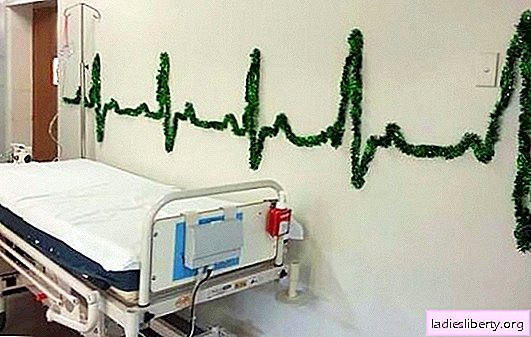
New Year's Eve is a real headache for emergency doctors. A common cause of accidents is alcohol poisoning. Sometimes medical specialists are called for trifling reasons: low-grade fever or small cuts. Few people know when to call an ambulance crew, and when you can get around with improvised means.
The most important reasons to call an ambulance
If the patient feels unwell due to the use of a high dose of alcohol, it is recommended to call an ambulance. The most important criterion: if vital functions suddenly go out of balance, emergency medical care is needed.
The most important reasons to call a doctor:
- Sudden loss of consciousness;
- Respiratory failure at rest;
- Severe chest pain;
- Pallor of the skin;
- Blue face
- Severe injury or bleeding.
A heart attack, stroke, pulmonary embolism, shock, severe bleeding or trauma are conditions in which every second is important.
A twenty-minute chest pain that radiates to the left arm, shoulder, or upper abdomen - sign of myocardial infarction. Heaviness (as if someone is sitting on his chest), burning in the heart and upper abdomen can also indicate heart attack.
Sudden unilateral paralysis of body parts with functional loss of facial muscles or speech impairment are signs of a stroke. There is a simple test that everyone can do: the patient should be able to raise both hands, palms up, smile and speak normally. If the arm, face is skewed or speech is impaired, the patient most likely stroke.
With thromboembolism pulmonary blood vessels partially or completely blocked. Symptoms: sudden shortness of breath, chest pain, sometimes unconsciousness, palpitations, shock.
Patients with embolism look very sick: the skin is pale, cold sweaty. The patient is often apathetic, disoriented, scared and has a fast pulse. Low blood pressure (below 100 mmHg), unconsciousness and respiratory arrest are characteristic of pulmonary embolism. In allergic shock, redness, itching, swelling, nausea, vomiting, diarrhea, and cramps are observed.
How to help a person before an ambulance arrives?
- Eliminate human disorientation.
You must regularly ask questions: "Can you hear me?" You should also shake your shoulders and check the reaction of the pupils to the light. If there is no breathing or a person is suffocating, it is necessary to release the airways and carry out mechanical ventilation.
- Give detailed information to the ambulance service.
If the patient says that he has severe pain and cannot breathe, an ambulance must be called immediately. If necessary, you should contact a passerby and ask him to call 112.
Answers to the following questions will give comprehensive information to the ambulance dispatcher:
- What happened?
- Where did it happen?
- How many injured or what disease does a person have?
- Who is calling?
Need to wait for other questions. You should not hang up until the conversation is over. Questions are needed to initiate additional assistance, such as opening the door of an apartment. If the call is made through a mobile phone, the department can find the person as soon as possible without indicating the location.
- Indirect cardiac massage.
Patients without a pulse and breathing need cardiopulmonary resuscitation. First, you should empty the chest. Then put your hand on the middle of the chest. You need to keep your arms straight and press on the chest vertically with your shoulders.
You need to press quickly: from 100 to 120 times per minute. The chest should fall by about 5-6 centimeters. No need to stop until help arrives. Trained assistants must perform mouth-to-mouth resuscitation. Ratio: 30 times push on the chest, exhale twice in the mouth.
Cardiopulmonary resuscitation is better than inaction. Broken ribs are the lesser of evils when it comes to human life.











